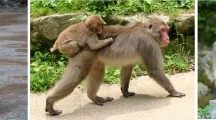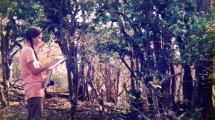Abstract
Using a focal animal technique, 16 juvenile female rhesus and bonnet macaques (2–3 years old) were observed with respect to the frequency and duration of their contacts with infants (0–1 year old). Each of these subjects was a member of one of four seminatural groups of macaques housed in 0.5-acre field cages at the California Primate Research Center. Rhesus juvenile females became very interested in infants when the latter were quite young, and maintained that interest throughout the study. When the infants were approximately 3–4 months old, the rhesus juveniles spent, on the average, 3.9 min/hr with those infants. By the time the infants were yearlings, the time spent with infants was approximately 6 min/hr. Relative to the rhesus, the bonnet juveniles showed less interest (about 2.2 min/hr) in young (3- to 4- month-old) infants, although by the time the infants were yearlings, the bonnets spent about 5.6 min/hr with them. Rhesus juveniles preferred sibling over nonsibling infants, but the presence of a sibling was not a necessary requirement for infant-directed behavior. The two bonnet juveniles who had infant siblings showed no preference for the latter. These data were interpreted within the framework of Quiatt’s [(1979) Am. Anthropol. 81: 310–319 conclusions about allomaternal behavior. Specifically, it was argued that, to the extent that there are species differences in maternal behavior, there should also be species differences in allomaternal behavior. The species differences in the maternal styles of rhesus and bonnet macaques provide a basis for an examination of this hypothesis.
Similar content being viewed by others
References
Blaffer-Hrdy, S. (1976). Care and exploitation of nonhuman primate infants by conspecifics other than the mother. In Rosenblatt, J., Hinde, R., Shaw, E., and Beer, C. (eds.),Advances in the Study of Behaviour, Vol. 6, Academic Press, New York, pp. 101–158.
Blaffer-Hrdy, S. (1978).The Langurs of Abu. Male and Female Strategies of Reproduction, Harvard University Press, Cambridge, Mass.
Brandt, E. M., and Mitchell, G. (1973). Pairing pre-adolescents with infants (Macaca mulatto).Dev. Psychol. 8(2): 222.
Caine, N. (1980).The Development of Peer Preferences in Immature Macaques, Unpublished Ph.D. dissertation, University of California, Davis.
Caine, N. G., and Mitchell, G. (1979). The relationship between maternal rank and companion choice in immature macaques (Macaca mulattoand M. radiata).Primates 20(4): 583–590.
Caine, N. G., Caine, C. Davidson, C., Maddock, J., Thompson, V., and Mitchell, G. (1980). Extra-troop orientation in two species of captive macaques (Macaca radiata & M. mulatto).Biol. Behav. (in press).
Jay, P. (1962). Aspects of maternal behavior among langurs.Ann. N.Y. Acad. Sci. 102: 468–176.
Jay, P. (1965). The common langur of N. India. In DeVore, I. (ed.),Primate Behavior: Field Studies of Monkeys and Apes, Holt, Rinehart and Winston, New York.
Jolly, A. (1966).Lemur Behavior, University of Chicago Press, Chicago.
Kaufman, I. C., and Stynes, A. J. (1978). Maternal separation of bonnet and pigtail macaque infants housed in mixed-species groups. Paper presented at the second annual meeting of the American Society of Primatologists, Atlanta, Ga.
Quiatt, D. (1979). Aunts and mothers: Adaptive implications of allomaternal behavior of nonhuman primates.Am. Anthropol. 81: 310–319.
Rosenblum, L. A. (1971a). Infant attachment in monkeys. In Schaffer, R. (ed.),The Origins Human Social Relations, Academic Press, New York.
Rosenblum, L. A. (1971b). The ontogeny of mother-infant relations in macaques. In Moltz, H. (ed.),The Ontogeny of Vertebrate Behavior, Academic Press, New York.
van Lawick-Goodall, J. (1968). The behaviour of free-living chimpanzees in the Gombe Stream Reserve.Anim. Behav. Monogr. 1: 165–311.
Author information
Authors and Affiliations
Rights and permissions
About this article
Cite this article
Caine, N.G., Mitchell, G. Species differences in the interest shown in infants by juvenile female macaques (Macaca radiata andM. mulatta). Int J Primatol 1, 323–332 (1980). https://doi.org/10.1007/BF02692277
Received:
Issue Date:
DOI: https://doi.org/10.1007/BF02692277




